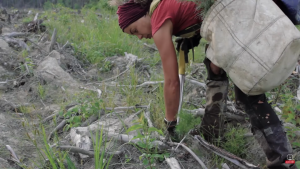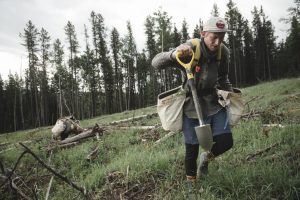The Overlooked Labor of Tree Planters
Written by: Erin Yoo
By now, most people have heard of ambitious goals in reforesting the planet. Perhaps the most famous of these efforts is the Trillion Trees Initiative, which was a global attempt to restore and plant not one million, not one billion, but one trillion trees by 2050 (“Forests are,” n.d.). Countries have supported and contributed to this initiative, like New Zealand which is currently on its way to plant one billion trees by 2028 (Ministry for Primary Industries, n.d.; Steffen, 2019). The Trillion Trees Initiative was even supported by former U.S. President Donald Trump, whose administration was infamous for prioritizing the economy over Earth throughout his presidency (Rudee, 2020). After much protesting and pushing for governments to take climate action, notably by youth, it can be relieving to see that many governments are committing to this environmentally conscious goal.
But, addressing the climate crisis is not just helpful for appeasing activists. Not only do trees suck out carbon and other greenhouse gases in the atmosphere, they also help address human health problems. For example, trees filter the air, decreasing rates and intensity of respiratory disease stemming from air pollution (Rudee). Trees can also provide economic benefits, as tree planting initiatives provide sustainable employment for thousands. Reports also show how trees increase prices of houses and other commodities, which consumers are willing to pay for (“How Trees,” n.d.). In short, trees deserve all the praise and credit they receive. But, how will the world reach the one trillion tree finish line? Who will put in the work? The answer lies in tree planters. Often overlooked, tree planters are those who dedicate their time to reforestation.
A Brief Job Description
Much physical and psychological strength is needed to persevere in this job, so many new planters actually quit in the beginning. Surprisingly, many consider the mental fortitude required in tree planters more important than the physical capabilities. As one tree planter in Quebec stated, “I think, personally, planting is maybe 30% physical. But it’s 70% psychological” (One Tree Planted, 2020). Planters must be able to wake up early each morning and face the day knowing what monotonous, strenuous work is ahead. Since the work is usually done individually, planters are kept company by their thoughts throughout the entire work day, which is understandably mentally draining (“Discover,” n.d.).
Despite — or perhaps due to — the vigorous labor, the work pays well (planters are paid by the number of trees they plant). On average, planters can earn $90 USD per day, but veteran planters can earn $169 USD each work day (“Discover,” n.d.). Plus, living and travel costs are paid for them (“Discover,” n.d.). This may come as no surprise due to the importance of the work. The same Quebec planter from above admitted, “The two reasons why I keep coming back to planting are the endorphins it gives you, and the other one for sure is the money” as seen in Figure 1 (One Tree Planted, 2020). This also makes tree planting an alluring summer job option for students (“The 5 Best,” n.d.).
The general minimum education requirement to hold this position is a high school diploma. However, those with extra forestry education and or experience may find more opportunities in tree planting (“At a Glance,” n.d.). Those with a few extra years under their belt may also supervise other planters in the field (“At a Glance,” n.d.). Another career area in tree planting is to become a forest manager, the person responsible for managing minute logistical details of planting. Forest managers must become intimately familiar with the numbers of tree planting operations each day: how many trees must be planted per unit area, how many trees must be planted per planter, distance needed between each planter, and more (RNZ, 2019).
Figure 1

“The two reasons why I keep coming back to planting are the endorphins it gives you, and the other one for sure is the money.”
Source: [One Tree Planted]
A Day in the Life of a Tree Planter
Waking up in the early hours of the morning around 5am, tree planters often work individually in remote, rough terrain in grid formation (One Tree Planted, 2020; RNZ, 2019). The work is more arduous and demanding than it may seem; planters carry heavy boxes of seedlings on their hips and backs and shovel the dense earth. The earth is likely filled with dead logs and other brush, as seen in Figure 2, so planters have to constantly dodge and maneuver their steps while carrying the burden of twenty kilograms on their torso (“Discover,” n.d.). Environmental conditions like bugs and weather can also take a toll on planters.
Experienced tree planters can plant up to 1,200 trees per day, going back and forth to the truck with materials multiple times to get more seedling boxes (RNZ, 2019). As Lisa Owen, a news correspondent in New Zealand, realized, much of the planting work has to be done with the feet because using your hands may cause back problems as you bend over. Other tasks during the planting day may entail unloading seedlings from trucks, watering and spraying seedlings, and moving trees from one location to another.
The day ends relatively early, and some planters can work as little as five hours each day (“Discover,” n.d.). By mid-afternoon, around 3 PM, most trees have been planted and the planters get to rest while heading back to their base camp. Back at camp, where planters usually live with dozens or a hundred other coworkers, planters may have to perform camp duties like washing the dishes (“At a Glance,” n.d.). In the evening, clothes, equipment, and food must be prepared for the next day, which will start early again. Overall, the majority of non-planting time is spent traveling, cleaning, and preparing, so free time is scarce.
Figure 2

A tree planter at work.
Source: [The Environmentor]
Conclusion
In order for the world to meet its united goal of planting vast amounts of trees, countries must rely on the labor of volunteers, environmental organizations, and especially tree planters. These extraordinary individuals have already made stunning progress in the past few years. In New Zealand, tree planting projects have resulted in 259 million trees planted in two years as of January 2021, or 26% of the billion tree goal (Ministry for Primary Industries, n.d.). At this rate, New Zealand will be able to successfully plant one billion trees in the next decade.
In 2020 alone, China, India, Ethiopia, Pakistan, and Mexico collectively planted approximately eight billion trees, making them the top five countries to plant the largest amount of trees that year (Stanton 2020). With these numbers, ambitious tree reforestation projects seem more and more likely to be successful in the end. Through their early mornings, mental discipline, and unwavering loyalty to the environment, tree planters have done the dirty work that often goes unmentioned in conversations of reforestation.
References and Sources
The 5 Best Things About Getting A Tree Planting Job. (n.d.). The Environmentor. Retrieved November 21, 2021, from https://blog.tentree.com/the-5-best-things-about-getting-a-tree-planting-job/
At a Glance. (n.d.). ECO Canada. Retrieved November 21, 2021, from https://eco.ca/career-profiles/tree-planter/
Discover the World of Tree Planting Job. Cleans Mind and Fills Pocket. (n.d.). Piplum. Retrieved November 21, 2021, from https://www.piplum.com/how-to/tree-planting/
Forests are our greatest hope. (n.d.). Trillion Trees. Retrieved November 21, 2021, from https://trilliontrees.org/
How Trees Make a Difference. (n.d.). National Wildlife Federation. Retrieved November 21, 2021, from https://www.nwf.org/Trees-for-Wildlife/About/Trees-Make-a-Difference.
Ministry for Primary Industries. (n.d.). Tracking planting for the One Billion Trees Programme. Ministry for Primary Industries. https://www.mpi.govt.nz/forestry/funding-tree-planting-research/one-billion-trees-programme/progress-towards-planting-one-billion-trees/tracking-planting-for-the-one-billion-trees-programme/
New Zealand – Land Area (sq. Km). (n.d.). Trading Economics. Retrieved November 21, 2021, from https://tradingeconomics.com/new-zealand/land-area-sq-km-wb-data.html
One Tree Planted. (2020, June 18). A Day in the Life of a Tree Planter | One Tree Planted [Video]. Youtube. https://www.youtube.com/watch?v=k68TTuQ5hJk
One Tree Planted. (2021, March 23). How Trees Grow | One Tree Planted [Video]. Youtube. https://www.youtube.com/watch?v=GtYCO0dHMfk
RNZ. (2019, June 12). How hard is it to plant trees for a living? Lisa Owen finds out [Video]. Youtube. https://www.youtube.com/watch?v=wOGnaurjOW8
Rudee, A. (2020, February 12). How and Where to Plant 60 Billion Trees in the US. World Resources Institute. https://www.wri.org/insights/how-and-where-plant-60-billion-trees-us
Stanton, K. M. (2020, November 25). Which Countries Are Planting the Most Trees? UniGuide. https://www.uniguide.com/countries-planting-the-most-trees/
Steffen, A. D. (2019, August 6). New Zealand Has Plan To Plant One Billion Trees By 2028. Intelligent Living. https://www.intelligentliving.co/new-zealand-billion-trees-2028/
United States – Land Area (sq. Km). (n.d.). Retrieved November 21, 2021, from https://tradingeconomics.com/united-states/land-area-sq-km-wb-data.html
Westerman Introduces Trillion Trees Act. (2020, February 12). Congressman Bruce Westerman. https://westerman.house.gov/media-center/press-releases/westerman-introduces-trillion-trees-act